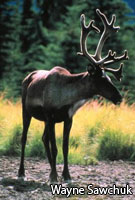
| Fire Destroys Woodland Caribou Habitat | 25 August 10 |
 The Wilderness Committee and Manitoba Wildlands are calling for an immediate year-long pause on industrial activity in the core habitat of the NAOSAP woodland caribou range which was ravaged by fire June 2010. The fire burned about 55,000 hectares of Manitoba boreal forest northwest of Grass River Provincial Park, between Flin Flon and The Pas. The burn area is the core habitat for the herd. The Wilderness Committee and Manitoba Wildlands are calling for an immediate year-long pause on industrial activity in the core habitat of the NAOSAP woodland caribou range which was ravaged by fire June 2010. The fire burned about 55,000 hectares of Manitoba boreal forest northwest of Grass River Provincial Park, between Flin Flon and The Pas. The burn area is the core habitat for the herd.Caribou are very susceptible to disturbance in their habitat, and industrial operations may further fragment remaining forested areas surrounding the burnt area. A pause in industrial activity through the next four important caribou activity cycles—fall breeding, winter foraging, spring migration, and summer calving—allows time to determine the impacts the fire will have on the NAOSAP herd. A recovery plan for the herd's future should be based on one year's study. "The bottom line is there is no protected habitat and now there's 55,000 hectares of significant habitat burned," stated Manitoba Wildlands Director, Gaile Whelan-Enns. Caribou were listed as threatened under Canada's Species At Risk Act in 2003, and under Manitoba's Endangered Species Act in 2006. The NAOSAP herd has been identified as one of the most at risk herds in the province. "If we find that the province isn't looking after caribou as well as they should be, then there are legal obligations under the Canadian Species At Risk Act which should be triggered," added Wilderness Committee Campaign Director, Eric Reder. Both the provincial Liberals and the Greens expressed support for the year-long pause. No one from Manitoba Conservation was available for comment August 20, 2010 View August 20, 2010 Wilderness Committee/Manitoba Wildlands Press Release (PDF)View August 20, 2010 Green Party of Manitoba statement of support (PDF) View August 21, 2010 Winnipeg Free Press article View August 21, 2010 CJOB article Watch August 20, 2010 CTV News at Six coverage View Manitoba Wildlands Biodiversity & Species page Source: Western Canada Wilderness Committee |
|
 Print version Print version |
Top |
